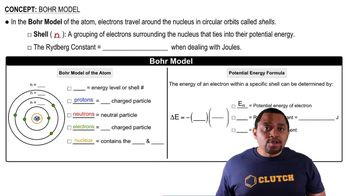Here are the essential concepts you must grasp in order to answer the question correctly.
Chemical Formula
A chemical formula is a symbolic representation of a chemical compound, indicating the types and numbers of atoms present. For example, H2O represents water, showing that it contains two hydrogen atoms and one oxygen atom. Understanding how to derive chemical formulas from molecular models is essential for accurately describing substances in chemistry.
Recommended video:
Molecular Models
Molecular models are three-dimensional representations of molecules that help visualize their structure and spatial arrangement. These models can be ball-and-stick, space-filling, or other types, each providing insights into the molecule's geometry and bonding. Recognizing how to interpret these models is crucial for translating them into chemical formulas.
Recommended video:
Color Codes in Chemistry
Color codes in chemistry are used to represent different elements or types of atoms in molecular models, aiding in the identification of components. For instance, in many models, carbon is often represented by black or gray, while oxygen is red. Familiarity with these color codes is important for accurately writing chemical formulas based on visual representations.
Recommended video:
 Verified step by step guidance
Verified step by step guidance


